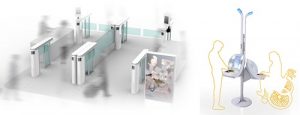
NEC’s face recognition tech to fly at airports in Japan
EP&T Magazine
Automation / Robotics Electronics Embedded Systems Engineering facial recognition facial recognitionJapanese multinational provider of IT services and products will deliver its customs procedure system at six major airports
NEC Corp. has received an order for an electronic customs procedure system utilizing face recognition to be installed at the customs inspection areas of six major airports in Japan.

Conceptual image of an electronic customs procedure gate at a customs inspection area (Left) Exit gate (Right) Electronic declaration terminal.
This electronic customs procedure system utilizes NEC’s face recognition technology, which boasts globally recognized recognition accuracy, and has already been put into operation at Narita International Airport Terminal 3 as of April 15 of this year. Japan Customs is now expanding this system throughout six major airports, which account for approximately 90% of the annual passengers entering Japan(3), aiming to commence operations from March 2020. These airports include the new Chitose Airport, Narita International Airport, Haneda Airport, Chubu International Airport, Kansai International Airport and Fukuoka Airport.
This system is designed to accelerate the customs procedures at leading airports, where NEC’s face recognition technology can confirm travelers’ identities when using the system’s electronic declaration terminal and passing through exit gates. Moreover, NEC aims to further accelerate customs procedures by enabling baggage to be reported electronically through the use of smartphone applications.
How it works
The electronic customs procedure system consists of customs declaration apps which simplify customs and declaration procedures for baggage, an electronic declaration terminal, and an exit gate that enables passengers to pass through using face recognition.
- Exit gate equipped with the world’s No.1 face recognition technology
The exit gate is equipped with NEC’s AI engine “NeoFace”, which is the core technology of NEC’s biometric identification portfolio “Bio-Idiom”(4), and has won the world’s No.1 recognition accuracy. The system operates by taking a facial image at an electronic declaration terminal installed at the customs inspection area, this image is then matched with a facial image that is taken by a face recognition camera at an exit gate. Since the face of a person approaching an exit gate is continuously photographed, walk-through authentication is possible, without requiring travelers to stop. Smooth identification contributes to reducing the congestion of customs inspection areas and shortening travelers’ waiting time.
- Customs declaration apps and an electronic declaration terminal
Customs declaration apps and an electronic declaration terminal enable efficient and easy electronic declaration for customs inspections. Travelers enter the contents of their portable goods with customs declaration apps, obtain a QR code, and then read their passport and the QR code with an electronic declaration terminal installed in the customs inspection area. This is considered more simple and easy when compared to preparing conventional forms for the “Declaration of Personal Effects and Unaccompanied Articles”.
In addition, during operation of the electronic declaration terminal, a traveler is photographed with a built-in camera and checked against their facial image embedded in the IC chip of their passport. The facial image taken at the terminal is only used for identification processes and is deleted in an appropriate manner after use.
